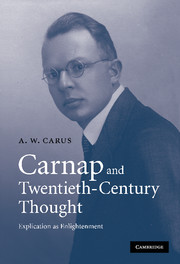Book contents
- Frontmatter
- Contents
- Preface
- Note on the style of citation
- Introduction
- 1 The cultural inheritance
- 2 The intellectual inheritance: positivism and Kantianism
- 3 The grand plan of a ‘system of knowledge’: science and logic
- 4 Carnap's early neo-Kantianism
- 5 The impact of Russell
- 6 Rational reconstruction
- 7 The impact of Wittgenstein
- 8 The crisis of rational reconstruction, 1929–1930
- 9 Liberation
- 10 Tolerance
- 11 The ideal of explication
- Bibliography
- Index
2 - The intellectual inheritance: positivism and Kantianism
Published online by Cambridge University Press: 22 September 2009
- Frontmatter
- Contents
- Preface
- Note on the style of citation
- Introduction
- 1 The cultural inheritance
- 2 The intellectual inheritance: positivism and Kantianism
- 3 The grand plan of a ‘system of knowledge’: science and logic
- 4 Carnap's early neo-Kantianism
- 5 The impact of Russell
- 6 Rational reconstruction
- 7 The impact of Wittgenstein
- 8 The crisis of rational reconstruction, 1929–1930
- 9 Liberation
- 10 Tolerance
- 11 The ideal of explication
- Bibliography
- Index
Summary
Kant and Goethe were the fixed points of the German intellectual firmament in Carnap's generation. Both had to be absorbed and digested by anyone with pretensions to Bildung. And both were common property among the factions; the two antagonistic traditions heroically or perversely combined by the young Carnap each had their own versions of Kant and Goethe. One theme in the following two chapters will be the exact sense in which the young Carnap can be called a ‘Kantian’. As we will see in the present chapter, that is not a straightforward question; a wide range of philosophies offered themselves as Kantian or neo-Kantian, including some now classified as ‘positivist’. Before we can begin with Carnap's own development, then, we must cast a glance at the intellectual surroundings he grew up in, particularly the aspects of Kant that made such widely divergent interpretations possible, and the subsequent rise of various neo-Kantian schools (such as the so-called ‘Marburg school’) following the Kant revival in the 1850s by the great physicist and physiologist Hermann von Helmholtz. As we will see, the ambition to create a scientific philosophy was widely felt on both sides of the divide – among positivists no less than among neo-Kantians. But no new synthesis was forthcoming; the obstacles were too great.
POSITIVISM
Even before he went to university, as we saw, Carnap had been influenced by Ernst Haeckel, whose side he had taken in a school discussion group. It was an exciting time to be in Jena.
- Type
- Chapter
- Information
- Carnap and Twentieth-Century ThoughtExplication as Enlightenment, pp. 65 - 90Publisher: Cambridge University PressPrint publication year: 2007



